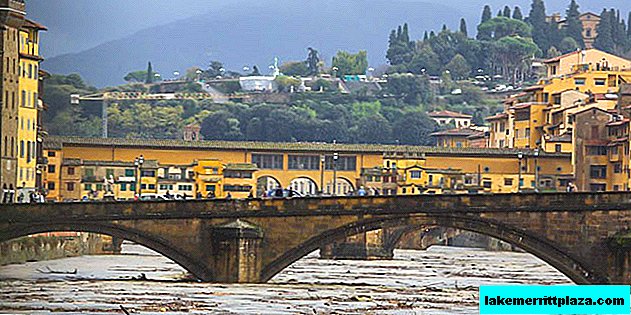Florence cannot be imagined without its main waterway - the Arno River, which crosses the city and creates a unique urban space. It is from its embankments that magnificent views of ancient buildings, palaces and cathedrals open, and river walks under the famous bridges on barchetto boats (barchetto) are especially popular among tourists.
Geographic data
The coast
Flowing along the hilly landscape of Florence, the Arno River conditionally divides the city into two parts, connected by ten bridges.
Right bank
On the right side is the historical center of the Tuscan capital. Here are concentrated large restaurants, shops, hotels and major tourist attractions. Some of the most popular include:
- Cathedral Square Duomo (Piazza del Duomo) and its unique temple complex;
- Piazza della Signoria, where the Palazzo Vecchio is located and the magnificent Loggia dell Lanzi loggia with priceless antiquity sculptures and works by Renaissance masters such as Donatello, Michelangelo (Michelangelo Bomelomelo) Ammannati);
- Centuries-old Basilica of St. Lawrence (Basilica di San Lorenzo);
- Laurenzian Library (Biblioteca Medicea Laurenziana) famous for its manuscript collections;
- Medici Riccardi Palace (Palazzo Medici Riccardi) - the standard of a secular building of the early Renaissance;
- Piazza Santa Croce and the Basilica of the same name, which is the tomb of the famous figures of art, culture and politics of Italy;
- Piazza della Santissima Annunziata is the best example of Renaissance architectural forms;
- Palazzo Strozzi and Palazzo Rucellai - examples of palace architecture of the Renaissance;
- Loggia del Mercato Nuovo (Loggia del Mercato Nuovo) - a favorite place for guests of Florence who want to buy souvenirs and other interesting things.
Left Coast
The left (southern) bank of the Arno River is called Oltrarno and was once considered the habitat of poorer citizens. This part of Florence is called "green" due to the picturesque landscapes of the hills and the wealth of examples of landscape art that have been carefully preserved since the Renaissance. Not only city visitors, but also locals come here to enjoy breathtaking views. A must-see place for tourists is Piazzale Michelangelo, located between the Boboli Gardens (giardino di Boboli) and the Bardini Park (giardino Bardini).
Floods
In the historical chronicles of the city, which has been recorded for more than 900 years, there are about 56 references to floods that occurred due to the fact that the Arno River overflowed its banks.
The first dates back to 1177. Almost every century, the water element caused catastrophic damage to the inhabitants of the Tuscan capital. The most tragic in this sense were 1333, 1557, 1740 and 1844.

The last flood occurred in 1966, and is considered the largest and most destructive. Then dozens of people's lives were claimed, thousands of priceless works of art and architectural monuments destroyed and damaged. The waters of the river rose to the level of 6 meters. The repositories of the National Central Library, which lost more than a third of the book collection (one and a half million copies), were particularly affected.
Bridges
Most of the Florentine bridges were destroyed by the German army at the end of World War II, and later rebuilt or rebuilt.

The retreating Nazi forces left only the Ponte Vecchio untouched. Four out of ten bridges were built in the second half of the 20th century, including modern automobile and railway engineering structures connecting both sides of the city.
Ponte Vecchio
Consisting of three arches, the Ponte Vecchio bridge (the name is translated from Italian as "old") occupies a leading position in the list of the most popular attractions of the Tuscan capital. Date of construction - 1345. It is noteworthy that it was erected in that part of the river where once, back in the ancient Roman era, there was a smaller-scale structure made of wooden flooring and stone props connecting the banks. The authorship of the elegant and durable design, which has remained unchanged to this day, belongs to the architect Neri di Fioravante.

A feature of the 32-meter bridge is a series of tightly standing buildings on each side of the structure, and the presence of an observation deck in the middle. Until the 16th century, there were shops selling meat and fish, which were later replaced by jewelry stores that exist today. Thanks to the latter, the bridge was called "Golden".
Ponte Alle Grazie
The modern ponte alle Grazie (ponte alle Grazie) was re-erected in 1957 on the site of an old bridge, destroyed by German troops in 1944.

The unique structure, created back in 1227, was considered in the middle of the last century the longest and most durable structure connecting both parts of the city.
Over its long history, the bridge has undergone many transformations and has been repeatedly modernized.

It acquired its current name in the 15th century thanks to the chapel of the same name., located here until 1876 along with workshops, shops, monasteries and other buildings.
Ponte Santa Trinita
Ponte Santa Trinita (Ponte Santa Trinita) was built in the middle of the XIII century. After another destructive flood that occurred in 1333, the lightweight wooden structure was replaced with a stone one, and in 1557 the bridge acquired its current appearance. It was destroyed by the Nazi army in 1944, and 13 years later restored, completely copying its original medieval appearance.

The monumentality of the design is combined with elegant arches soaring above the water, which creates a feeling of lightness and sophistication. The sophistication of the architectural style is enhanced by statues installed at the entrance to the bridge, and personifying the seasons.








